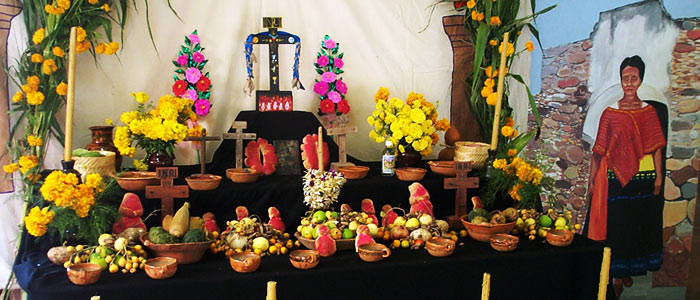Feature Image by José Guadalupe Posada
Sugar skulls, dancing skeletons, and colorful altars. Scary costumes, witches, and black cats. These are just a few of the symbols representing the Day of the Dead and American Halloween. While the holidays share similar dates (Halloween is October 31st, and the Day of the Dead starts on October 31st and lasts through November 2nd), Halloween is a day of trick-or-treating and dressing up. Day of the Dead is quite different.
Before the Spanish conquest, the Aztec, Maya, Zapotec, Mixtec, and Toltec cultures celebrated the Day of the Dead. The Aztecs, for example, held a month-long celebration dedicated to Mictecacihuatl, goddess of the afterlife. They would take the skulls of their deceased loves ones and place them on altars, praising and dancing around them in celebration of the lives they once lived. After the Spanish arrived, they saw their celebrations and tried to convert the indigenous peoples to Catholicism. The Spanish moved Day of the Dead from August to November to coincide with the Catholic holidays of All Saints’ Day (November 1st) and All Souls’ Day (November 2nd). On All Saints’ Day, it is customary to honor dead saints. On All Souls’ Day, people light candles and pray for the ones who have passed. Although the Day of the Dead some commonalities with All Souls’ Day, ancient traditions and folklore are still the main ingredients in this cauldron. In Mexico you can still find rich traditions and fun celebrations with paper-mache skeletons and skulls, sugar skeletons baked in bread, parades in the street, and my favorite, decorated graveyards. Altars honoring the dead are decorated as vibrantly as rainbows with pictures towering over ofrendas, or offerings to the deceased ones, such as art, knick-knacks, fruits, drinks, and anything else they enjoyed.
El Dia De Los Muertos isn’t only celebrated in Mexico and here in the United States. Guatemalans and Bolivians visit their loved ones’ graves and play music for them. Brazilians celebrate in a similar way but call this holiday Dia de Finados. Ecuadorians celebrate Dia de los Difuntos on November 2nd, holding festive gatherings at cemeteries and preparing traditional foods for this holiday, such as colada morada, a drink made from purple maize and blueberries, and guaguas de pan, sweet bread shaped like infants.
In other parts of the world, people also celebrate the lives of deceased loved ones. In China they call it “Teng Chieh.” They place food and water in front of photos of those who have passed, and they light lanterns and place them on the streets to light paths for the dead. In Czechoslovakia, chairs are placed by the fireplace for each of the dead family members. In Germany, they put away knives and sharp objects for the night so no evil spirit finds them. In Sweden, children do not attend school from Oct 31st to Nov 6th, in honor of remembering the dead.
Whether in Latin America, Europe or the United States, Day of the Dead-type holidays are celebrated by different cultures in different ways. Yet these holidays all tell the same story: remembering and celebrating loved ones and having fun loving life while remembering death.


